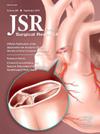Surviving not Thriving After Gunshot Wound: Prospective Study of Quality of Life, PTSD, and Employment
IF 1.8
3区 医学
Q2 SURGERY
引用次数: 0
Abstract
Introduction
Psychosocial morbidity, including posttraumatic stress disorder (PTSD), depression, and failure to return to work, is common following gunshot wounds (GSWs). GSW victims with retained bullets experience increased rates of elevated blood lead, putting patients at risk for toxic effects on cognition and mood. This pilot study was performed to examine associations between retained bullets and employment and psychosocial outcomes after GSW.
Methods
Adult victims of interpersonal intentional GSW completed surveys using validated instruments to measure quality of life, PTSD, resilience, and substance use, and questions regarding employment during index hospitalization and at 1 and 3 mo. Survey data was linked to clinical records regarding injury severity and hospital course.
Results
Sixty-three patients completed the baseline survey; 43 completed all 3 surveys. Median age was 29 (interquartile range, 21-40), injury severity score 13 (9-17), and hospital length of stay 6 d (4-10). The patient population was overwhelmingly Black and male (both 87.3%). Laparotomy was performed in 28 patients (44%). Forty-nine patients (77.8%) were working prior to injury, 1 (2%) at 1 month, and 34 (54%) at 3 months. Eight (12.7%) screened PTSD + at baseline; 38 (60.3%) were PTSD + at 3 months. Three-month PTSD + patients were similar to PTSD-patients in all clinical and demographic variables. For 3-month PTSD + patients, all quality of life component scores were worse than for PTSD-patients. Presence of retained bullets was not associated with any differences in psychosocial outcome at 3 months.
Conclusions
GSW is associated with significant psychosocial morbidity, including a large decline in employment. PTSD affects approximately half of patients, consistent with prior reports. In this pilot study, PTSD + patients suffered from reduced quality of life.
求助全文
约1分钟内获得全文
求助全文
来源期刊
CiteScore
3.90
自引率
4.50%
发文量
627
审稿时长
138 days
期刊介绍:
The Journal of Surgical Research: Clinical and Laboratory Investigation publishes original articles concerned with clinical and laboratory investigations relevant to surgical practice and teaching. The journal emphasizes reports of clinical investigations or fundamental research bearing directly on surgical management that will be of general interest to a broad range of surgeons and surgical researchers. The articles presented need not have been the products of surgeons or of surgical laboratories.
The Journal of Surgical Research also features review articles and special articles relating to educational, research, or social issues of interest to the academic surgical community.

 求助内容:
求助内容: 应助结果提醒方式:
应助结果提醒方式:


